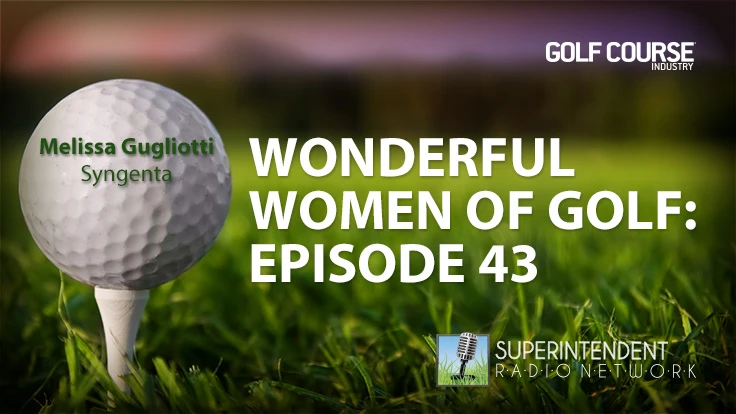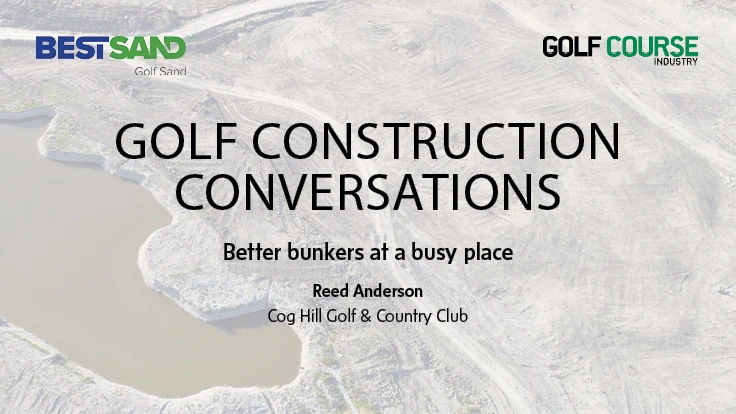
Courtesy of Sean Anderson
A street of homes, the Intracoastal Waterway, an estuary and an exclusive island separate Eagle Point Golf Club’s more than 200 acres from the Atlantic Ocean. Besides the southeast corner of the grounds, where the ninth hole parallels the Intracoastal, Eagle Point is more akin to a rolling and selectively wooded inland championship golf course than a site one mile from an ocean.
While it can’t be seen from the polished fairways and greens, the Atlantic factors into nearly every decision superintendent Sean Anderson and his team make. A Tom Fazio design, Eagle Point opened in 2000 and returned Wilmington, North Carolina, to the national golf scene by hosting the PGA Tour’s Wells Fargo Championship in 2017. Anderson arrived on New Year’s Day 2019, as the club was in the final phases of repairing damage caused by Hurricane Florence.
Weather swings are a big part of the coastal golf story, a reality Anderson experienced during his 13 years as superintendent at Card Sound Golf Club in the Florida Keys. His first two years at Eagle Point included two storms requiring significant cleanup efforts: Hurricane Dorian in 2019 and Hurricane Isaias in 2020. How to limit damage caused by mega-storms and assessing course infrastructure in the back nine of its life cycle are critical parts of Anderson’s long-term agenda.
“It has endured some pretty good hurricanes over the last couple of years,” Anderson says. “We have had some pretty extensive tree and landscape damage. With this club being 20 years old and the weather-related issues we’ve had — and the irrigation system is 20 years old — I feel my responsibility and role with the club right now is to determine how we ensure the next 20 years of success.”
Proximity to the ocean affects Eagle Point in non-weather ways. Little Creek and Middle Sound Estuary border the course and provide separation between inland development — most of which has occurred within the past 20 years — and the ocean. Further protection for runoff from impervious surfaces comes in the form of a human-created pond surrounding the 9-hole par-3 course. A pump system recycling water from low to high areas and into Fazio-designed water features add another buffer between developed and environmentally sensitive areas. Moving more than 2 million cubic yards of dirt during construction produced uncharacteristic topography for a Lowcountry setting.
Eagle Point has evolved from a club with significant spring and fall play into a summer haven for golf enthusiasts and beachgoers. The evolution of member usage altered the agronomics and greens were converted from bentgrass to G12 Bermudagrass following the 2017 Wells Fargo. The 150 acres of maintained turf also includes 60 acres of Tifsport Bermudagrass fairways, approaches and tees on the championship and par-3 courses.
The club has invested in tools to help its turf team maintain the abundance of short grass. Eagle Point was an early adopter of GPS-guided spraying technology, becoming one of the first Southeast facilities to incorporate the Toro Multi Pro GeoLink GPS Sprayer into its agronomic programs. The Multi Pro with GeoLink proved successful at treating the Tifsport surfaces without overlapping or encroaching into sensitive areas for multiple years before Anderson’s arrival. Having a course already mapped and extensive digital spray records available via the GeoLink system allowed Anderson to immediately make confident decisions while learning a new property that must coexist with natural surroundings.
“They were early adopters and we have continued that trend,” Anderson says. “We’re not overlapping and we’re getting that pinpoint accuracy. You can define all your areas. If you’re doing fairway applications, then you’re just spraying the fairways and there’s a reduction from not overspraying in non-targeted areas. You’re not spraying 10 feet into your roughs.”
Quantifying input reductions is tricky, because Anderson has never treated Eagle Point’s fairways, approaches and tees with a conventional sprayer. Like most courses, Eagle Point closely managed labor during the early stages of the pandemic, so Anderson used the Multi Pro on greens instead of a walk-behind sprayer for a period last spring.
“There were so many unknowns and just organizing and coordinating tasks was a little bit challenging,” he says. “We would go in and use the GPS sprayer on greens. We got comfortable with it and we did find we were about 10 percent less on square footage using our GPS sprayer because we weren’t spraying into collars.”
Eagle Point’s use of emerging technology extends into its mowing program. The club’s fleet includes six Toro Reelmaster 5010-H fairway mowers, which utilize a 24.8 hp diesel engine operating in conjunction with a self-recharging 48-volt battery pack. The mower features a hybrid system, called PowerMatch, designed to coordinate the power generated with the required cutting conditions. Eagle Point also has five Greensmaster TriFlex 3320 mowers, which are used for maintaining approaches, verticutting and occasionally mowing greens.
“I have tried to adopt those types of mowers anywhere I can,” Anderson says. “The main reason is the hydraulic leaks with the older technology. You get scarred up pretty good when you get a nice hydraulic leak. We’re trying to eliminate all the hydraulic leak points, which is huge for a presentation and aesthetic standpoint on a golf course.”
Less hydraulics and noise are making an already peaceful place even more serene. Asked where he goes to absorb Eagle Point scenes, Anderson initially refers to the wooded southwest edge of the property. But selecting just one peaceful spot at Eagle Point is like forcing a healthy eater to declare a favorite vegetable. “This golf property is very scenic and there are numerous spots on this property where you just step back and you’re like, ‘Wow, this is a nice office to work in,’” Anderson says.
The office supports pleasant visitors. Marshes and waterways as neighbors lead to interactions with myriad wildlife, ranging from blue herons to snapping turtles. The course’s name — and Bald Eagle Lane address — are fitting, because eagles are spotted above the grounds.
Eagle Point’s footprint includes 14 acres of native areas consisting of muhly grass, spartina patens and cordgrass. The native areas contrast the Bermudagrass hues and monochromes of 25 acres of tidy pine straw.
A western Washington native whose career has included stops in Colorado, Germany, New York and Florida, Anderson is relishing the blend of high-level maintenance and escapism Eagle Point provides.
“It’s a coastal property and you have a couple of holes on the marshes where you get that typical Lowcountry feel,” Anderson says. “But when you get to the middle and other parts of the golf course, you almost feel like you’re more in Atlanta, Georgia, with the undulation and elevation. It’s got a uniqueness to it.”
Latest from Golf Course Industry
- Melrose leadership programs sending 17 to GCSAA Conference and Trade Show
- Maximizing your experience at trade shows: tips and etiquette for attendees
- Tubac’s Rancho 9 re-opens after greens renovation
- Future Leaders Academy set for Jan. 23 in suburban Pittsburgh
- 54, Turfgrass set to manage Druids Glen, Curracloe Links
- Nufarm introducing new products in San Diego
- Envu Superintendent Grant Program sending 10 members to 2025 GCSAA show
- Editor’s notebook: Let’s chat about AI





